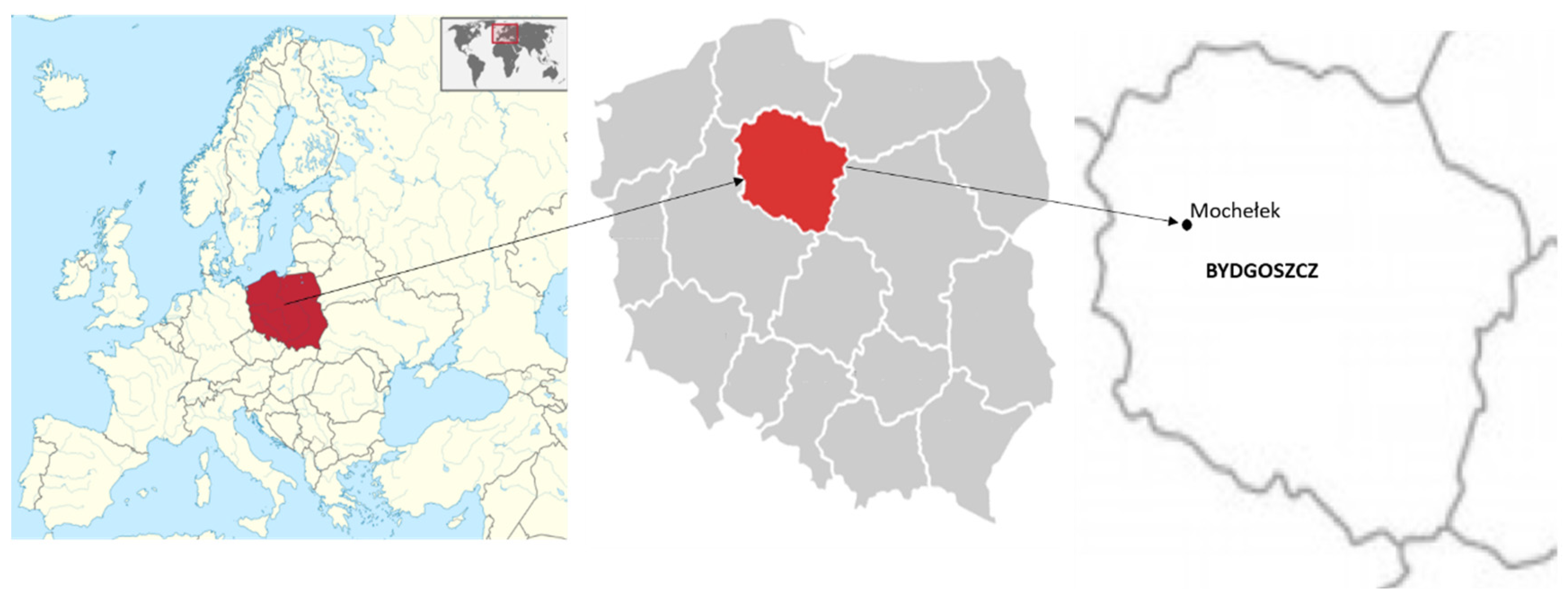Effect of Sowing Method on Yield of Different Plants Grown as a Catch Crop
Abstract
:1. Introduction
2. Materials and Methods
2.1. Experiment Site
2.2. Experiment Design
- -
- Furrow sowing (FS)—sowing in 6–8 cm-deep farrows [24],
- -
- Traditional (row) sowing (TS).
- -
- White mustard cv. ‘Warta’,
- -
- Tansy phacelia cv. ‘Anabela’,
- -
- Common buckwheat cv. ‘Panda’,
- -
- Common vetch cv. ‘Fama’.
2.3. Agrotechnical Practices
2.4. Samples and Measurements
2.5. Data Analysis
3. Results
3.1. Seedbed Moisture Content and Plant Density
3.2. Plants Height and Yields
4. Discussion
5. Conclusions
Author Contributions
Funding
Institutional Review Board Statement
Informed Consent Statement
Data Availability Statement
Acknowledgments
Conflicts of Interest
References
- Kahimba, F.C.; Sri Ranjan, R.; Froese, J.; Entz, M.; Nason, R. Cover crop effects on infiltration, soil temperature, and soil moisture distribution in the Canadian prairies. Appl. Eng. Agric. 2008, 24, 321–333. [Google Scholar] [CrossRef]
- Kocira, A.; Staniak, M.; Tomaszewska, M.; Kornas, R.; Cymerman, J.; Panasiewicz, K.; Lipińska, H. Legume cover crops as one of the elements of strategic weed management and soil quality improvement. A Review. Agriculture 2020, 10, 394. [Google Scholar] [CrossRef]
- Wanic, M.; Żuk-Gołaszewska, K.; Orzech, K. Catch crops and the soil environment—A review of the literature. J. Elem. 2019, 24, 31–45. [Google Scholar] [CrossRef]
- Khangura, R.; Ferris, D.; Wagg, C.; Bowyer, J. Regenerative Agriculture—A Literature Review on the Practices and Mechanisms Used to Improve Soil Health. Sustainability 2023, 15, 2338. [Google Scholar] [CrossRef]
- Jaskulski, D.; Jaskulska, I. Diversity and dominance of crop plantations in the agroecosystems of the Kujawy and Pomorze region in Poland. Acta Agric. Scand. Sect. B–Soil Plant Sci. 2011, 61, 633–640. [Google Scholar] [CrossRef]
- Żuk-Gołaszewska, K.; Wanic, M.; Orzech, K. The role of catch crops in field plant production—A review. J. Elem. 2019, 24, 575–587. [Google Scholar] [CrossRef]
- Vonk, W.; Ittersum, M.; Reidsma, P.; Zavattaro, L.; Bechini, L.; Guzmán, G.; Pronk, A.; Spiegel, H.; Steinmann, H.; Ruysschaert, G.; et al. European survey shows poor association between soil organic matter and crop yields. Nutr. Cycl. Agroecosyst. 2020, 118, 325–334. [Google Scholar] [CrossRef]
- Thorup-Kristensen, K.; Nielsen, N.E. Modelling and measuring the effect of nitrogen catch crops on the nitrogen supply for succeeding crops. Plant Soil 1998, 203, 79–89. [Google Scholar] [CrossRef]
- Qi, Y.; Zhou, R.; Nie, L.; Sun, M.; Wu, X.; Jiang, F. The Effects of Catch Crops on Properties of Continuous Cropping Soil and Growth of Vegetables in Greenhouse. Agronomy 2022, 12, 1179. [Google Scholar] [CrossRef]
- Lipiec, J.; Doussan, C.; Nosalewicz, A.; Kondracka, K. Effect of drought and heat stresses on plant growth and yield: A review. Int. Agrophys. 2013, 27, 463–477. [Google Scholar] [CrossRef]
- Tribouillois, H.; Dürr, C.; Demilly, D.; Wagner, M.-H.; Justes, E. Determination of Germination Response to Temperature and Water Potential for a Wide Range of Cover Crop Species and Related Functional Groups. PLoS ONE 2016, 11, e0161185. [Google Scholar] [CrossRef]
- Ciscar, J.C. The impacts of climate change in Europe (the PESETA research project). Clim. Chang. 2012, 112, 1–6. [Google Scholar] [CrossRef]
- Hulme, M.; Doherty, R.; Ngara, T.; New, M.; Lister, D. African climate change: 1900–2100. Clim. Res. 2001, 17, 145–168. [Google Scholar] [CrossRef]
- Stagnari, F.; Maggio, A.; Galieni, A.; Pisante, M. Multiple benefits of legumes for agriculture sustainability: An overview. Chem. Biol. Technol. Agric. 2017, 4, 2. [Google Scholar] [CrossRef]
- Yuvaraj, M.; Pandiyan, M.; Gayathri, P. Role of Legumes in Improving Soil Fertility Status; Intech Open: London, UK, 2020. [Google Scholar]
- Sun, J.; Zhao, J.; Zhang, T.; Yu, L.; Jin, K. Effects of a Furrow-Bed Seeding System on Stand Establishment, Soil Bacterial Diversity, and the Yield and Quality of Alfalfa Under Saline Condition. Front. Plant Sci. 2022, 13, 919912. [Google Scholar] [CrossRef] [PubMed]
- Wilczewski, E.; Sokół, B.; Nowicki, R.; Jug, I.; Pietrzykowski, K.; Gałęzewski, L. Response of Field Pea and Common Vetch, Grown as a Catch Crop, on the Sowing Method. Agriculture 2023, 13, 3. [Google Scholar] [CrossRef]
- Keeler, A.M.; Rafferty, N.E. Legume germination is delayed in dry soils and in sterile soils devoid of microbial mutualists: Species-specific implications for upward range expansions. Ecol. Evol. 2022, 12, e9186. [Google Scholar] [CrossRef] [PubMed]
- Müller, F.; Masemola, L.; Britz, E.; Ngcobo, N.; Modiba, S.; Cyster, L.; Samuels, I.; Cupido, C.; Raitt, L. Seed Germination and Early Seedling Growth Responses to Drought Stress in Annual Medicago L. and Trifolium L. Forages. Agronomy 2022, 12, 2960. [Google Scholar] [CrossRef]
- WRB. World Reference Base for Soil Resources 2014, Update 2015. International Soil Classification System for Naming Soils and Creating Legends for Soil Maps; World Soil Resources Reports No. 106; FAO: Rome, Italy, 2015. [Google Scholar]
- Piotrowska-Długosz, A.; Wilczewski, E. Influence of catch crops and its incorporation time on soil carbon and carbon related enzymes. Pedosphere 2015, 25, 569–579. [Google Scholar] [CrossRef]
- Wikimedia.org. Poland. Available online: https://upload.wikimedia.org/wikipedia/commons/b/bd/Poland_in_Europe.svg (accessed on 25 September 2023).
- Wikimedia.org. Kuyavian-Pomeranian Voivodeship. Available online: https://en.wikipedia.org/wiki/Kuyavian-Pomeranian_Voivodeship#/media/File:Kujawsko-pomorskie_(EE,E_NN,N).png (accessed on 25 September 2023).
- Wilczewski, E.; Harasimowicz-Hermann, G. Bruzdowy Sposób Siewu Rzepaku Ozimego. (Furrow Method of Sowing WinterOilseed Rape). Patent No. PL 215714, 31 January 2014. [Google Scholar]
- Harasimowicz-Hermann, G.; Kaszkowiak, J.; Wilczewski, E. Redlica Do Bruzdowego Wysiewu Nasion. (Coulter for Furrow Sowing of Seeds). Patent No. PL 68430, 30 June 2016. [Google Scholar]
- Gomez, K.A.; Gomez, A.A. Statistical Procedures for Agricultural Research, 2nd ed.; John Wiley & Sons: Hoboken, NJ, USA, 1984. Available online: https://pdf.usaid.gov/pdf_docs/PNAAR208.pdf (accessed on 28 August 2023).
- Jambor, M. Effect of seeding rate and seeding date on creation of yield of selected winter oilseed rape varieties and hybrids. J. Agric. Sci. 2007, 53, 49–57. [Google Scholar]
- Lääniste, P.; Joudu, J.; Eremeev, V.; Mäeorg, E. Effect of sowing date and increasing sowing rates on plant density and yield of winter oilseed rape (Brassica napus L.) under Nordic climate conditions. Acta Agric. Scand. Sect. B-Soil Plant Sci. 2008, 58, 330–335. [Google Scholar] [CrossRef]
- Kazemeini, S.A.; Edalat, M.; Shekoofa, A.; Hamidi, R. Effects of nitrogen and plant density on rapeseed (Brassica napus L.) yield and yield components in Southern Iran. J. Appl. Sci. 2010, 10, 1461–1465. [Google Scholar] [CrossRef]
- French, R.J.; Seymour, M.; Malik, R.S. Plant density response and optimum crop densities for canola (Brassica napus L.) in Western Australia. Crop Past. Sci. 2016, 67, 397–408. [Google Scholar] [CrossRef]
- Harker, K.N.; O’Donovan, J.T.; Smith, E.G.; Johnson, E.N.; Peng, G.; Willenborg, C.J.; Gulden, R.H.; Mohr, R.M.; Gill, K.S.; Weber, J.D.; et al. Canola growth, production, and quality are influenced by seed size and seeding rate. Can. J. Plant Sci. 2017, 97, 438. [Google Scholar] [CrossRef]
- Romaneckas, K.; Steponavičius, D.; Jasinskas, A.; Kazlauskas, M.; Naujokiene, V.; Bručiene, I.; Švereikaite, A.; Šarauskis, E. How to Analyze, Detect and Adjust Variable Seedbed Depth in Site-Specific Sowing Systems: A Case Study. Agronomy 2022, 12, 1092. [Google Scholar] [CrossRef]
- Rinaldi, M.; Di Paolo, E.; Richter, G.M.; Payne, R.W. Modelling the effect of soil moisture on germination and emergence of wheat and sugar beet with the minimum number of parameters. Ann. Appl. Biol. 2005, 147, 69–80. [Google Scholar] [CrossRef]
- Kutcher, H.R.; Malhi, S.S. Residue burning and tillage effects on diseases and yield of barley (Hordeum vulgare) and canola (Brassica napus). Soil Till. Res. 2010, 109, 153–160. [Google Scholar] [CrossRef]
- Kaszkowiak, J.; Wilczewski, E. Utility Model, Redlica do Siewu Bruzdowego z Regulowaną Głębokością Przykrycia” (Coulter for Furrow Sowing with Adjustable Cover Depth). Patent No. PL Ru 73139Y1, 2 October 2023. [Google Scholar]
- Szatkowski, A.; Sokólski, M.; Załuski, D.; Jankowski, J.J. The effects of agronomic management in different tillage systems on the fall growth of winter oilseed rape. Agriculture 2023, 13, 440. [Google Scholar] [CrossRef]
- Gałęzewski, L.; Jaskulska, I.; Kotwica, K.; Lewandowski, Ł. The Dynamics of Soil Moisture and Temperature—Strip-Till vs. Plowing—A Case Study. Agronomy 2023, 13, 83. [Google Scholar] [CrossRef]
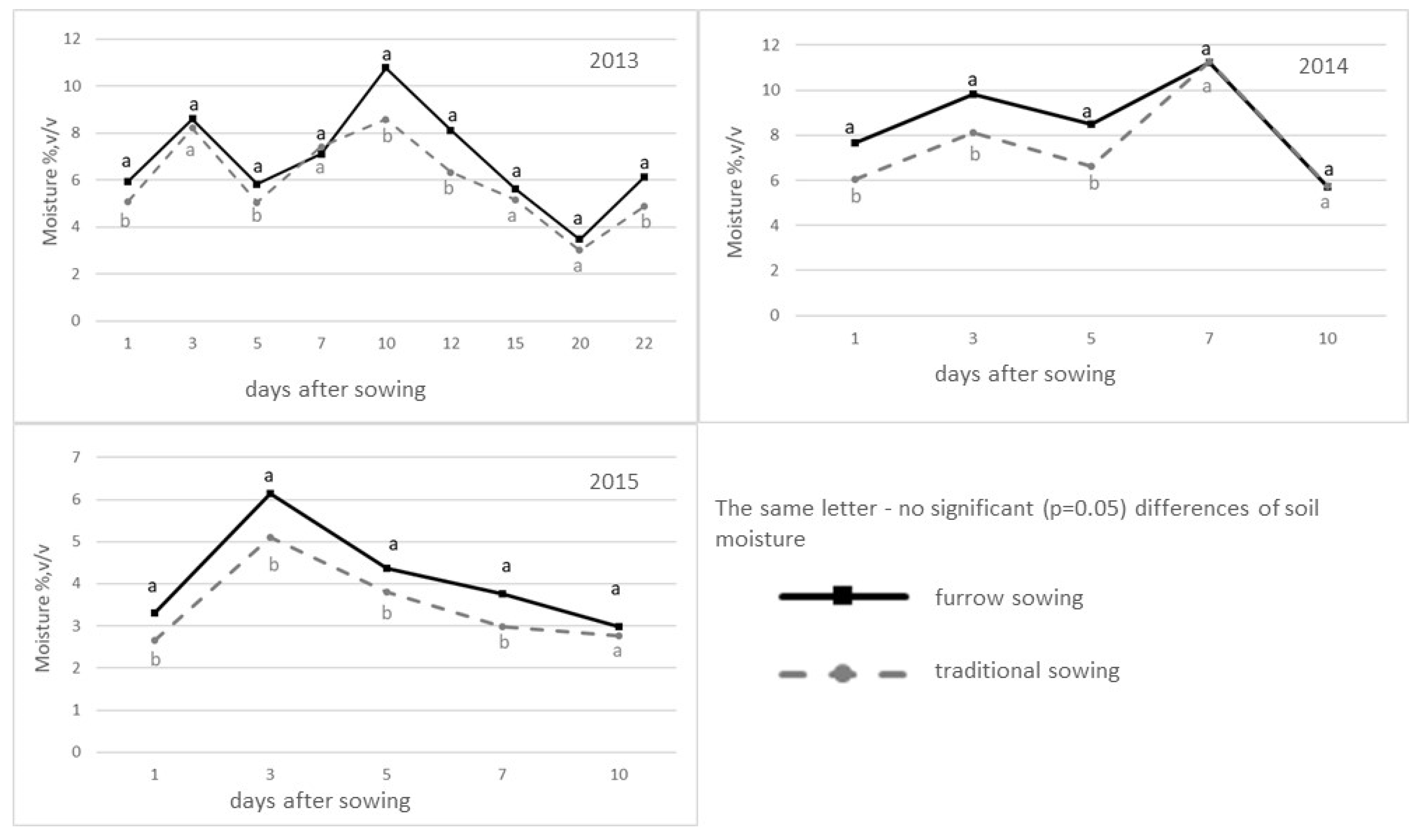
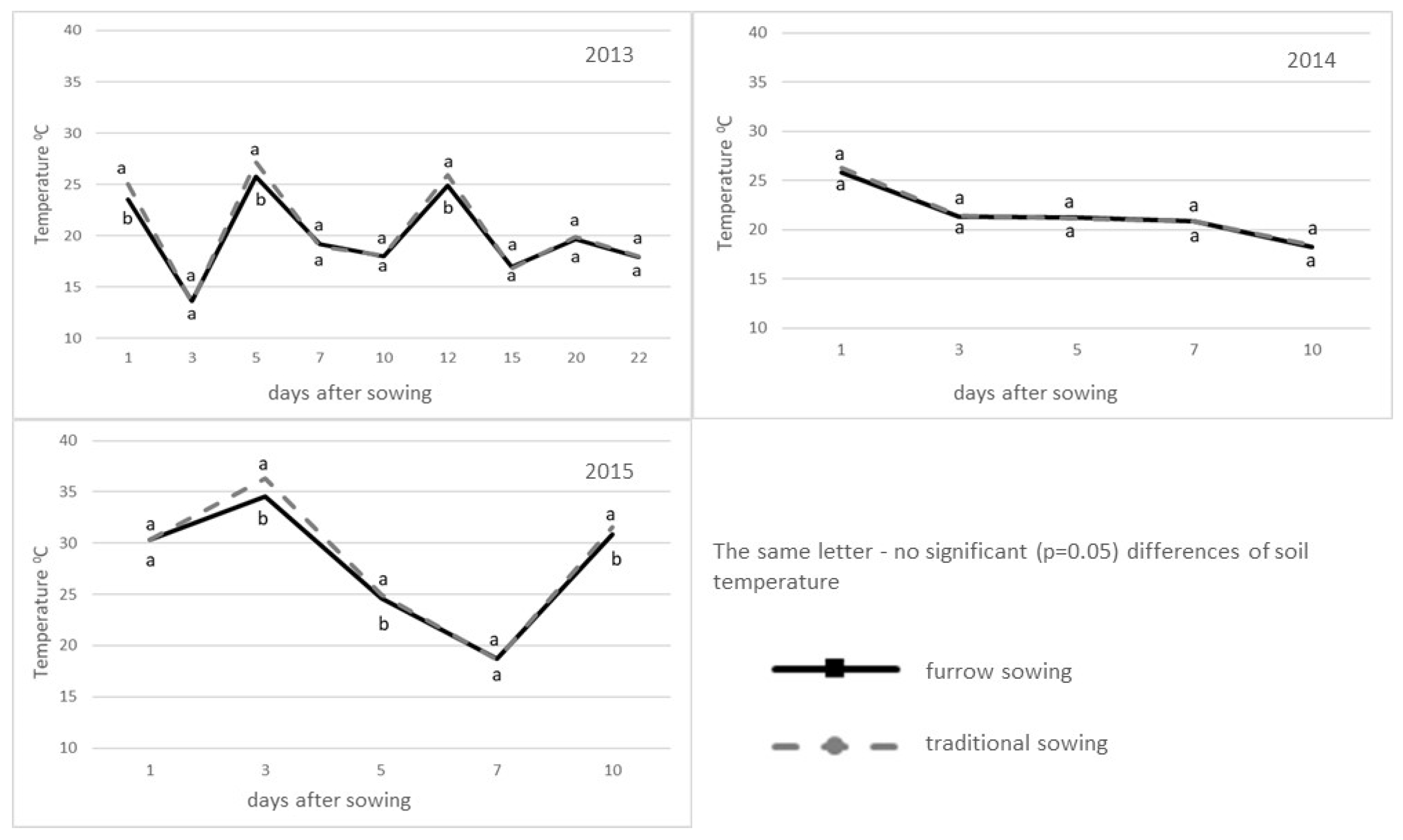

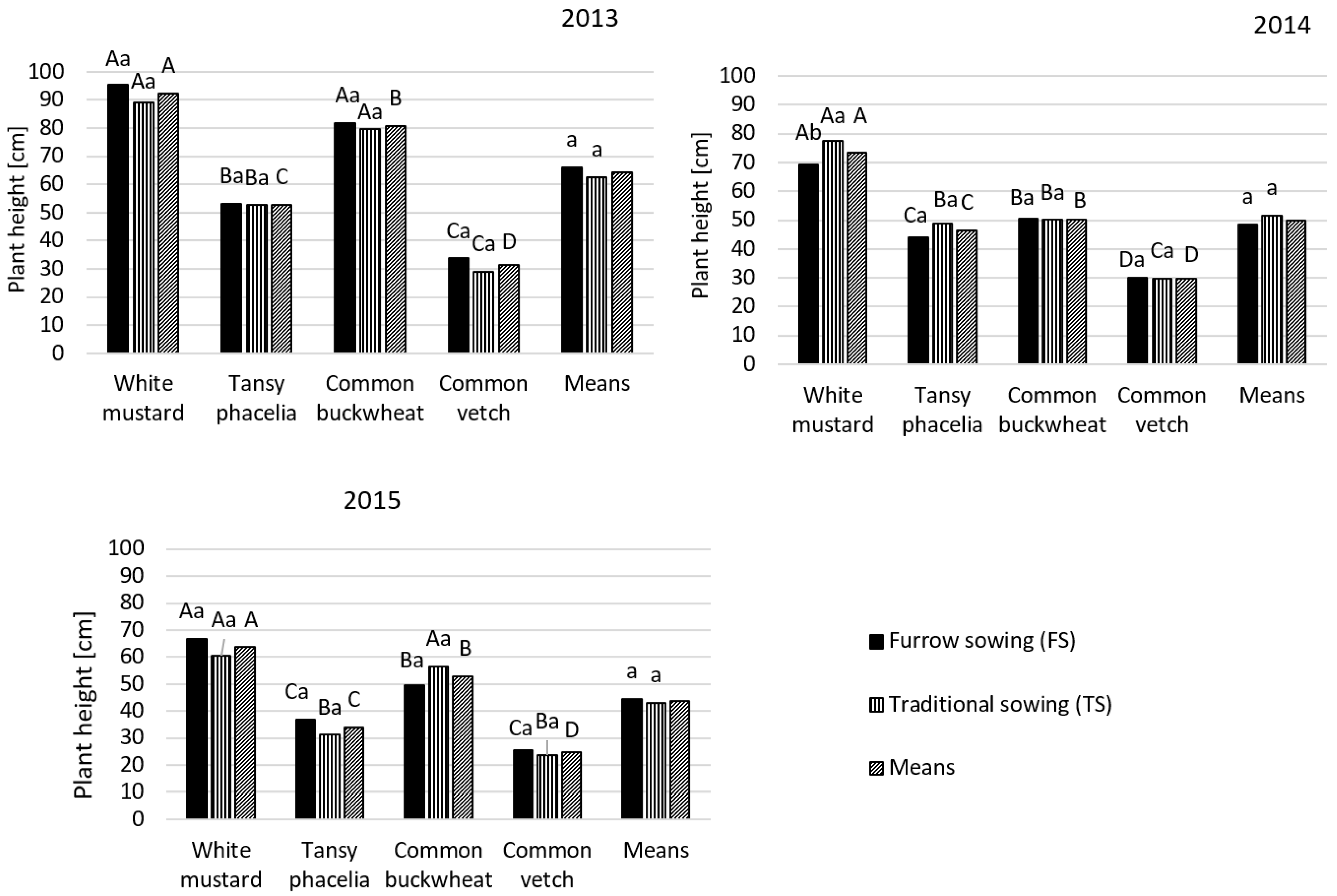

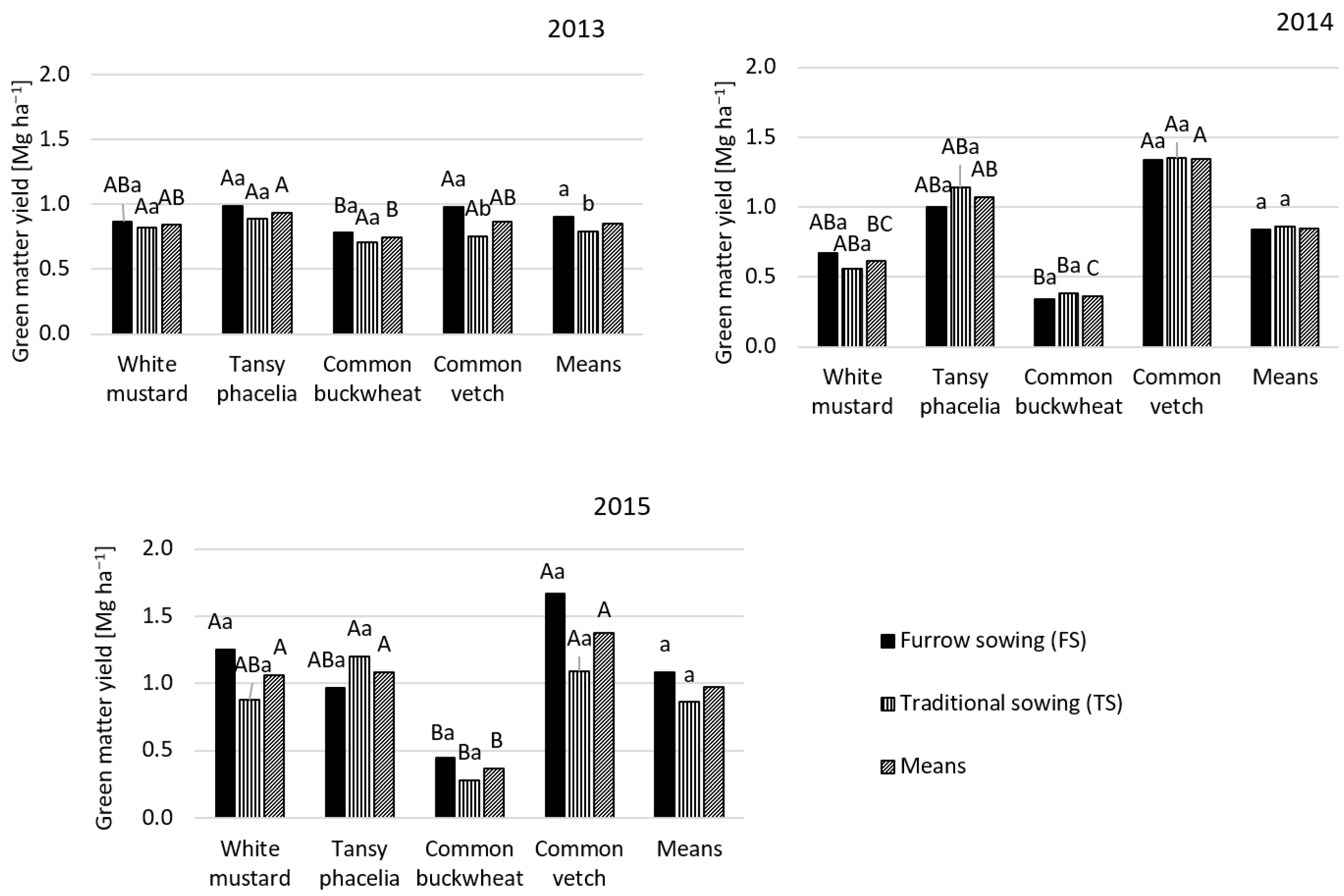
| 2013 | 2014 | 2015 | 2013–2015 | 1949–2019 | 2013 | 2014 | 2015 | 2013–2015 | 1949–2019 | |
|---|---|---|---|---|---|---|---|---|---|---|
| Month | Precipitation—Sum (mm) | Temperature—Mean (°C) | ||||||||
| July | 79.0 | 55.4 | 50.4 | 61.6 | 74.3 | 18.9 | 21.5 | 18.5 | 19.6 | 18.1 |
| August | 56.6 | 57.3 | 20.3 | 44.7 | 53.2 | 18.1 | 17.2 | 20.9 | 18.7 | 17.6 |
| September | 64.1 | 25.9 | 52.4 | 47.5 | 42.1 | 10.7 | 14.4 | 13.8 | 13.0 | 13.3 |
| October | 18.6 | 18.0 | 20.9 | 19.2 | 34.3 | 8.2 | 9.6 | 6.4 | 8.1 | 8.2 |
| Sum/mean VII–X | 218.3 | 156.6 | 144.0 | 173.0 | 203.9 | 14.0 | 15.7 | 14.9 | 14.9 | 14.3 |
| Factor | Plant Density | |||
|---|---|---|---|---|
| White Mustard | Tansy Phacelia | Common Buckwheat | Common Vetch | |
| Sowing | 9.79 * | 1.18 NS | 3.30 NS | 0.81 NS |
| Sowing × years | 2.96 NS | 5.20 ** | 1.84 NS | 1.51 NS |
| Time | 7.95 ** | 3.86 NS | 132.70 *** | 176.20 *** |
| Time × years | 3.10 * | 11.08 *** | 1.54 NS | 2.27 NS |
| Interaction | 0.09 NS | 0.00 NS | 0.25 NS | 0.15 NS |
| Interaction × years | 0.62 NS | 0.24 NS | 0.60 NS | 0.51 NS |
| Factor | Yield | Plant Height | |
|---|---|---|---|
| Dry Mass | Post-Harvest Residues | ||
| Sowing | 4.14 NS | 0.59 NS | 0.12 NS |
| Sowing × years | 0.55 NS | 0.10 NS | 0.42 NS |
| Species | 1.82 NS | 20.71 *** | 43.54 *** |
| Species × years | 7.71 *** | 1.35 NS | 3.63 ** |
| Interaction | 0.29 NS | 0.50 NS | 0.06 NS |
| Interaction × years | 0.37 NS | 0.25 NS | 0.50 NS |
Disclaimer/Publisher’s Note: The statements, opinions and data contained in all publications are solely those of the individual author(s) and contributor(s) and not of MDPI and/or the editor(s). MDPI and/or the editor(s) disclaim responsibility for any injury to people or property resulting from any ideas, methods, instructions or products referred to in the content. |
© 2023 by the authors. Licensee MDPI, Basel, Switzerland. This article is an open access article distributed under the terms and conditions of the Creative Commons Attribution (CC BY) license (https://creativecommons.org/licenses/by/4.0/).
Share and Cite
Wilczewski, E.; Gałęzewski, L. Effect of Sowing Method on Yield of Different Plants Grown as a Catch Crop. Sustainability 2023, 15, 14829. https://doi.org/10.3390/su152014829
Wilczewski E, Gałęzewski L. Effect of Sowing Method on Yield of Different Plants Grown as a Catch Crop. Sustainability. 2023; 15(20):14829. https://doi.org/10.3390/su152014829
Chicago/Turabian StyleWilczewski, Edward, and Lech Gałęzewski. 2023. "Effect of Sowing Method on Yield of Different Plants Grown as a Catch Crop" Sustainability 15, no. 20: 14829. https://doi.org/10.3390/su152014829
APA StyleWilczewski, E., & Gałęzewski, L. (2023). Effect of Sowing Method on Yield of Different Plants Grown as a Catch Crop. Sustainability, 15(20), 14829. https://doi.org/10.3390/su152014829







